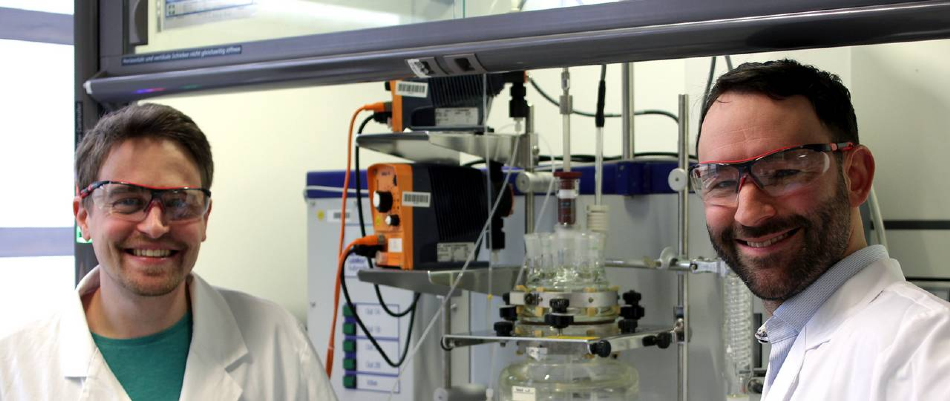Jan 28 2020
Polyamides that are contained in cars, ski bindings, or items of clothing are important plastics. To date, crude oil is mainly used for commercial production of these plastics. Very few “green” alternatives to these plastics exist, for instance, castor-oil-based polyamides.
 The two authors, Paul Stockmann and Dr. Daniel Van Opdenbosch, with the reactor in which the polymerizable monomer was produced from the natural product 3-carene. Image Credit: C. Zollfrank/TUM.
The two authors, Paul Stockmann and Dr. Daniel Van Opdenbosch, with the reactor in which the polymerizable monomer was produced from the natural product 3-carene. Image Credit: C. Zollfrank/TUM.
Since bio-based compounds are usually very costly to synthesize, until now, they have only been able to hit the market if they have had certain unique properties.
Researchers under the guidance of Volker Sieber, Professor of the Chemistry of Biogenic Raw Materials at TU Munich, have now created a totally new polyamide class that can be synthesized from a byproduct of cellulose production.
New Polyamide Family
The biogenic starting material, (+)-3-carene, is formed of two rings, fused to one another. Now, the TUM chemists and the chemists from Fraunhofer Institute for Interfacial Engineering and Biotechnology (IGB) in Straubing have altered one of the rings such that it can be opened up, resulting in a long chain of molecules, a polymer.
The second ring is left untouched. Thus, rather than being a linear polymer chain similar to those in conventional polyamides, a chain with several small rings and other side groups arises. This proffers the polymer with totally new functionalities.
Special Properties
The new polyamides are splendid due to their unique properties, which make them desirable for many applications. For instance, when compared to the contending crude oil-derived products, they melt at higher temperatures. Moreover, it is possible to produce the new compounds transparently, or as partially crystalline materials, thereby increasing the possibilities of their later application using the same originating substance.
By way of reaction conditions and catalysts during synthesis, we can easily control whether we will obtain a transparent or partially crystalline polyamide in the end. However, the basis for this is offered above all by the specific structure of the bio-based starting material which would be very expensive to obtain from fossil raw materials.
Volker Sieber, Professor of the Chemistry of Biogenic Raw Materials, Technical University of Munich
Increasing Sustainability
From an industrial perspective, it is crucial for the production to essentially occur in a single reaction container. Sieber stated that this “one-pot” method would not only enable a considerable reduction in costs, but would also translate into an evident increase in sustainability.
It is actually possible to distill the biogenic starting material (+)-3-carene at a relatively low cost and high purity from the turpentine oil synthesized as a secondary product in the cellulose industry. To date, heating of the turpentine oil was carried out only in the cellulose factories.
We use it as a vital starting material for plastics. This is an enormous increase in value.
Volker Sieber, Professor of the Chemistry of Biogenic Raw Materials, Technical University of Munich
No Competition with Food Production
According to Sieber, since turpentine oil is a byproduct generated in the forest industry, in contrast to using castor oil, researchers are not competing against food production. Still, the researchers are not totally pleased with the overall yield of the process, which is 25% by mass at present.
Thanks to the simple scalability, the potential for an efficient process is very high.
Paul Stockmann, Study Author, Technical University of Munich
Stockmann’s doctoral thesis at the TUM is based on the outcomes of this study. The chemist is currently working, at the Fraunhofer IGB, toward launching (+)-3-carene-based polyamides in the market as alternatives to high-performance polyamides derived from crude oil.